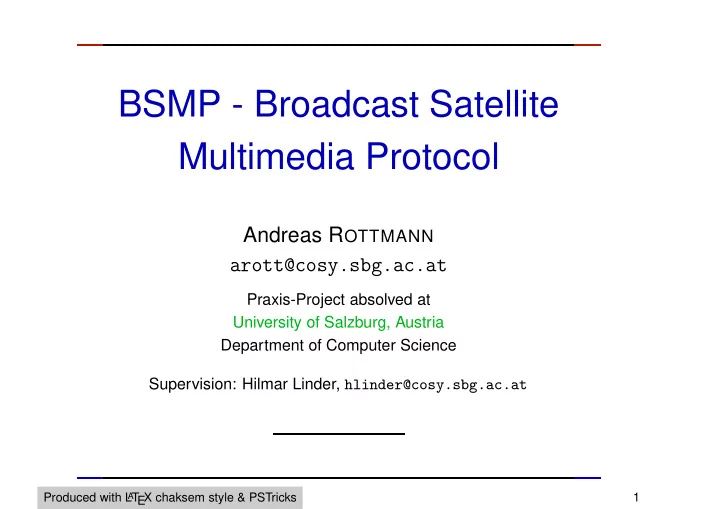

BSMP - Broadcast Satellite Multimedia Protocol Andreas R OTTMANN arott@cosy.sbg.ac.at Praxis-Project absolved at University of Salzburg, Austria Department of Computer Science Supervision: Hilmar Linder, hlinder@cosy.sbg.ac.at Produced with L A T EX chaksem style & PSTricks 1
O VERVIEW ➀ Multicast Introduction ➁ Reliable Multicast ➂ BSMP Overview ➃ Design & Implementation ➄ Tools O VERVIEW 2
M ULTICAST I NTRODUCTION Why multicast: ➜ When sending same data to multiple receivers ➜ Save bandwidth over multiple unicast connections ➜ Receivers’ addresses unknown Multicast Applications: ➜ Audio/Video conferencing and “broadcasts” ➜ News distribution ➜ Software updates (e.g. clusters, workstation sets) ➜ Resource discovery/advertisement ➜ . . . M ULTICAST I NTRODUCTION 3
IP Multicast: ➜ RFC 1112 (Host Extensions for IP Multicast) ➜ Multicast groups, having IPv4 class D or IPv6 multicast addresses ➜ Members of groups may be located anywhere on the Internet ➜ Members join and leave groups and tell the routers via IGMP (RFC 3376) ➜ Senders do not need to be member of the multicast group ➜ Routers use multicast routing protocols to manage groups ➜ IP-Multicast is best-effort (unreliable) M ULTICAST I NTRODUCTION 4
R ELIABLE M ULTICAST Problems: ➜ ACK-based schemes (like used in TCP) don’t scale ➜ Request explosion ➜ Reply explosion Solutions: ➜ NAK-based scheme (receiver estimates a timeout and sends a NAK after that) ➜ NAK-filtering ➜ FEC encoding R ELIABLE M ULTICAST 5
BSMP O VERVIEW What it is: ➜ Multicast Protocol, built upon UDP/IP Multicast ➜ Designed for the requirements of satellite transmissions • Long RTT • Asymmetric communication (receiver feedback via wired Internet) ➜ Offers different levels of reliability ➜ Implemented as a shared library offering an C API similar to POSIX sockets ➜ Successor of RRMP (Restricted Reliable Multicast Protocol), written by Hilmar Linder and Klaus Siegesleitner ➜ Complete re-write and re-design • Essentially the same features • Less than half of the core code size BSMP O VERVIEW 6
Protocol Key Points: ➜ Built on UDP ➜ Preserves message boundaries ➜ Groups messages into transmission groups (TGs) ➜ TGs have a sequence number ➜ NAK-based retransmission scheme ➜ Retransmissions are FECs over a TG ➜ Per-receiver RTT estimation BSMP O VERVIEW 7
Features: ➜ Four modes (service classes) • Full reliability • Proactive • Limited reliability • Unreliable ➜ Designed for asymmetric communication ➜ Data-rate control ➜ Interleaving (protection against burst losses) ➜ Two NAK suppression algorithms (default, LE-SBCC) ➜ Portable (POSIX, Windows using WSA) BSMP O VERVIEW 8
BSMP Socket API (simplified): ➜ bsmp_socket(family, style) ➜ bsmp_join(sock, if_addr, mc_addr) ➜ bsmp_leave(sock, if_addr) ➜ bsmp_connect(sock, if_addr, mc_addr) ➜ bsmp_send(sock, data) , ➜ bsmp_recv(sock, data) ➜ bsmp_close(sock) BSMP O VERVIEW 9
D ESIGN & I MPLEMENTATION Overview: BSMP Socket API User Data User Data Receive Queue Send Queue Receiver Thread Sender Thread PDUs PDUs TG Assembler TGs Retrans. FEC Table Encoder TG TGs Table Timeout Interleaver FEC req. TGs PDUs PDUs NAK NAK Filter Scheduler Estimators NAK PDUs PDUs POSIX Socket API Network − UDP Multicast Network − UDP Unicast D ESIGN & I MPLEMENTATION 10
Code Structure: ➜ Data structures (object-oriented C) • Timer queue • Data rate estimator • Socket address routines • PDU • Transmission group • Send queue, receive queue • Transmission group table • Virtual socket layer ➜ Sender logic ➜ Receiver logic D ESIGN & I MPLEMENTATION 11
Timer queue: ➜ Core component, used for all timeouts ➜ Sender thread and receiver thread run in a loop, with an iteration at least about every 10 msecs ➜ There may be many outstanding timeouts (each TG has a timeout) ➜ Once each iteration, there is a timer queue “clock-tick” ➜ Clock-ticks do not need to be uniformly spaced ➜ All timers that have already expired at the clock-tick are invoked and removed from the queue ➜ Efficient implementation: timer start and remove are both O (log n ) (balanced binary tree) D ESIGN & I MPLEMENTATION 12
Virtual Socket Layer: ➜ Abstracts the operations needed on an underlying socket (normally POSIX or WSA) ➜ Used to implement sockets that communicate via thread-safe queues (in-process) ➜ Primarily for testing Software and APIs used: ➜ GLib 2.0 ➜ POSIX threads ➜ POSIX socket API (WSA on Windows) ➜ ISO C, written for POSIX APIs D ESIGN & I MPLEMENTATION 13
T OOLS Sample sender and receiver: ➜ Simple, general-purpose BSMP sender/receiver ➜ Allows access to all protocol options Test Torture: ➜ Test program ➜ Uses virtual socket layer ➜ Generates randomly-sized packets with random content ➜ Checks if they are correctly received ➜ Can be configured via an XML config file: • Link properties (delay, loss rate) • Protocol options (mode, data rate, . . . ) T OOLS 14
T HE E ND Thanks for Your Attention! T HE E ND 15
Recommend
More recommend